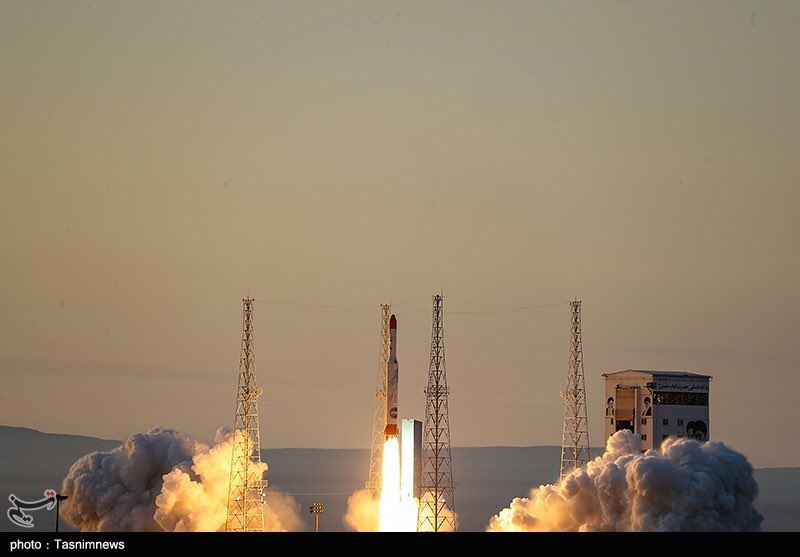In a move that is likely to anger the US and other Western powers in the midst of prolonged negotiations to restore the 2015 nuclear deal, an Iranian rocket recently launched three unspecified devices into space.
“Three research devices were sent into space by the Simorgh satellite launcher,” said Ahmad Hosseini, a spokesman for the defense ministry, as quoted by state television. “For the first time, three devices were launched simultaneously at a speed of 7,350 meters per second over a distance of 470 kilometers,” Hosseini said.
پرتاب تحقیقاتی #ماهوارهبر_سیمرغ
سخنگوی فضایی وزارت دفاع:
ماهوارهبرِ سیمرغ سه محموله تحقیقاتی را با موفقیت به فضا پرتاب کرد
در این مأموریت، برای نخستین بار ۳ محموله به صورت همزمان به ارتفاع ۴۷۰ کیلومتری و با سرعت ۷۳۵۰ متر بر ثانیه پرتاب و محقق گردید pic.twitter.com/SFF6lMmd5z
— خبرگزاری تسنیم 🇮🇷 (@Tasnimnews_Fa) December 30, 2021
However, details about the launch date and devices carried by the rocket were not disclosed. It remained unclear if any of the devices managed to leave Earth’s orbit. “The performance of the space center and the performance of the satellite carrier was done properly,” said Hosseini. He called the launch was “initial”, implying that more could be on the anvil.

“The research goals set for this launch have been met,” Hosseini said, without going into further details. Iranian television broadcast the footage of the white rocket, emblazoned with the words “Simorgh satellite carrier” and the motto “We can”, blasting into the morning sky from Iran’s Imam Khomeini Spaceport. “Another triumph by Iranian scientists,” a state television correspondent at a nearby desert site said during the launch.
Iranian state media has recently published a schedule of future satellite launches for the country’s civilian space program. Moreover, Iran’s powerful paramilitary Revolutionary Guard carried out a successful satellite launch into orbit last year as part of their parallel space program.
Iran’s Space Program
Iran has been developing its space capabilities in the past few years and is attempting to expand its position in space. Last year, the spokesman for the Iranian Defense Ministry’s Space Group announced that the country is planning to unveil two domestically made satellite carriers in the near future.
Assad Hosseini, the Iranian foreign ministry’s spokesman, boasted at the time that Iran had become the seventh country to develop space technology of this kind. Meanwhile, Iranian news agency Tasnim has stated that the upcoming launch of the homegrown ‘Zafar’ satellite would have a 25-meter precision, which will be corrected to 16 meters in future launches.
A Cover For Ballistic Missile Activity?
Officials in the United States have long suspected that Iran’s pursuit of satellite technology is a cover for ballistic missile development. Such satellite launches, according to the US, violate a UN Security Council resolution requiring Iran to refrain from any activities related to ballistic missiles capable of delivering nuclear weapons. The US has warned that satellite launch technology might aid Iran’s development of intercontinental ballistic missiles (ICBMs).
Meanwhile, Tehran has refuted these claims, saying that it is not working on a nuclear weapons program. In April 2020, Iran’s Islamic Revolutionary Guard Corps surprised the world by successfully launching Nour (light), its first military satellite.
The launch also saw the UN Security Council pass Resolution 2231 with ex-US Secretary of State Mike Pompeo stating that Tehran must be held accountable. Israel was likewise alarmed by the launch. “Israel strongly condemns the Revolutionary Guard’s launch of a military satellite by a terrorist organization designated by the US,” the Isareli foreign ministry said in a statement, asking for fresh sanctions against Tehran.
Germany, France, and the United Kingdom have all expressed their displeasure. However, the deployment, according to Russia, did not breach any UN resolutions. Following Trump’s withdrawal from the landmark Iran nuclear deal negotiated by the Obama administration, tensions between the two countries have risen dramatically.
The latest move comes amid ongoing talks in Vienna about the potential of reviving the Iran nuclear deal. The decision to launch the rocket/missile in the midst of already tense negotiations is characteristic of Iran’s hardline administration.
President Ebrahim Raisi, who took over from the more moderate Hassan Rouhani in January 2021, is considered closer to Ayatollah Ali Khamanei and more distrustful of the United States and other Western nations. The current US administration under President Joe Biden is making efforts to re-enter into the nuclear deal with Iran.
- Contact the author at ashishmichel@gmail.com
- Follow EurAsian Times on Google News